36th Field Artillery Group
519th Field Artillery
(Sondhofen / Babenhausen)
______________________________________


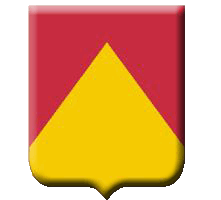



Burg Sonthofen


The U.S. Constabulary School
Sonthofen
_________________________________
What was the U.S. Army Constabulary?

(click on the button to find out)
_________________________________
The history of the 519th Field Artillery Battalion 1954 source: 36th FA GP year book  THE 519th Field Artillery Battalion has an interesting and outstanding history. Originally the Second Battalion of the 35th Field Artillery Regiment organized in August 1918, and later known as the 977th Field Artillery Battalion, the 519th received its actual redesignation as such on 5 February 1947. It was called back to active duty at Sonthofen, Germany, 20 May 1949, as part of the U.S. Constabulary Forces. Meanwhile it had acquired Battle Honors for the campaigns of Naples-Foggia, Anzio, Rome-Arno, Southern France, Rhineland, Ardennes-Alsace and Central Europe. It had fired in support of three armies, five corps, 21 divisions, three brigades and six regiments. The battalion saw 492 days of combat, and suffered 205 casualties. Total missions fired: 5,934; total rounds: 118,710, for an average of 241 rounds. Number of gun tubes worn out: 84. "Power and Vigilance" is the motto of the 519th. Its power was ably demonstrated in the record it chalked up during World War II; its vigilance goes unquestioned as it takes its stand as a proud unit of the U.S. Army on the job in Western Europe. The Shield of the 519th indicates its lineage from the 35th Field Artillery Regiment. The red interior together with the diagonal bar was the shield of the 35th Regiment. The present shield was produced by adding a plain border about the original shield, and addition of fleur-de-lis as a symbol of World War II service in the European Theater. A change in permanent duty station was made from Sonthofen to Babenhausen on — March 1951. While in Germany, the 519th has participated in every major maneuver and achieved an enviable record for speed and accuracy in firing. There is no question that the men serving with the 519th Field Artillery Battalion are proud to do so. |
519th Field Artillery Battalion 155 mm Howitzer Towed Sonthofen – Babenhausen    Lineage & Commanding Officers  ________________ May 20, 1949 Activated from 91st Constabulary Squadron 7732 Arty Gp Sonthofen LTC Hopkins 1949 -1950 Sonthofen 7732th Arty Gp ________________ August 30, 1950 7732 Arty Group re-designated 36th Arty Gp LTC Weston A. Mc Cormack 1950 Jul 1952 Sonthofen 36th Arty Gp LTC Eugene Wilson Jul 1952 1954 Babenhausen 36th Arty Gp LTC Ernest B. Wilder 1954 Babenhausen 36ty Arty Gp ________________ 519th Field Artillery Battalion activated at Sonthofen, Germany 20 May 1949 519th Field Artillery Battalion redeployed to Babenhausen 1950 519th Field Artillery Battalion gyroscoped to Fort Lewis, WA 519th Field Artillery Battalion inactivated at Fort Lewis, WA 25 Jun 1958 |

LTC Ernest B. Wilder
Co 519 Field Artillery
36ty Arty Gp
1954
Click here to read Biography from 1954
________________________
All photos 36th FA GP
©1954
©1954

The headquarters battery wire section,
"If you say it, we will lay it"

The Aviation section working on a L-19

At the Hq. and SVC. battery mess hall
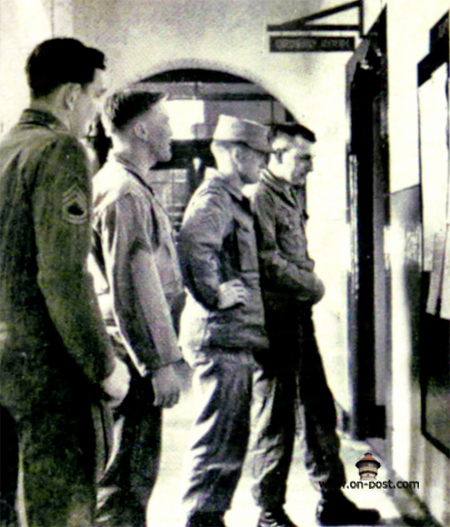
Who's on Detail?
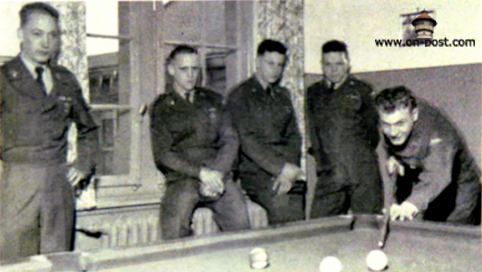
Sgt. Mulvy, "A" battery Commo Chief figures a pool problem

Pvt. Delbert Riehl and Pvt. Billy Spears bulging bicepts.

Sgt. John Row, and his "B" Battery crew
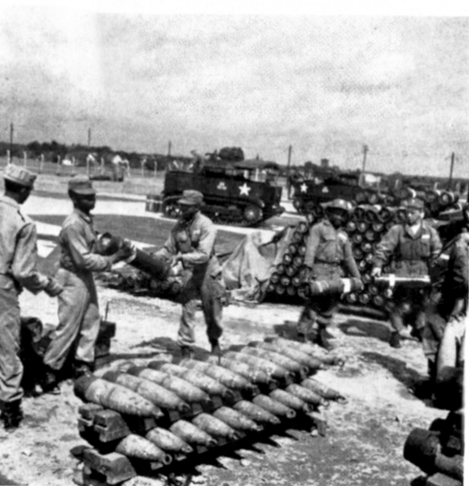
"B"Battery Ammo section stacking 'em
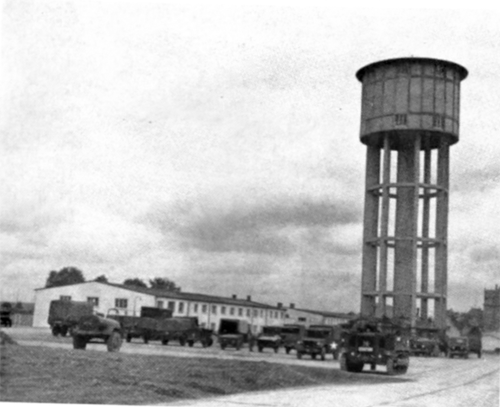
A view at the motorpool
____________________________________
Wayne E. Dixon 7732 FA Gp & 36th FA Gp I was a direct assignment to the US Constabulary. When I enlisted in the service at the age of 16, I signed up for the Constabulary. Having completed basic training at Fort Knox, we were shipped over to Germany. Upon arrival in the port of Bremerhaven, they sent us to Marburg, where we were finally loaded on trains and sent south to Sonthofen, from the top of Germany to the bottom. My first assignment was with the 94th Field Artillery, part of the 7732 FA Group. The trip on the train was one rough and cold ride. I served as a radio operator for the forward observer in A Battery, 94th Field Artillery Battalion. I believe it was in 1950 that we were re-designated as the 517th Field Artillery Battalion. We were moved from Sonthofen to Wetzlar up above Frankfurt. During my stay in Sonthofen up on the Burg, at that time there were the 91st and 94th Field Artillery, under the command of the 7732 FA Group Headquarters. I was a very impressionable person having been so young and the first time really away from home. I loved the mountains and the country around the station. I was told that the German Army had used the burg as the German West Point before we had taken over the post. The Constabulary had closed their School and quite a few of the troops were assigned into the Artillery units there. I was returned back down to Sonthofen from Wetzlar, and assigned to Group Headquarters. The 7732 Field Artillery Group was re-designated as the 36th FA Group and moved to the town of Babenhausen south of Frankfurt, between Darmstadt and Aschaffenburg. While assigned to the 36th, I worked in the S-2/3, and assigned as the Colonel's driver. After my re-enlistement I was sent to Murnau to attend Surveying School. We were re-assigned from the Constabulary and assigned to 7th Army. I remained with Group Headquarters till I volunteered for Korea in 1953 and was transferred to the 28th Infantry Division for advanced refresher before shipping over to Korea. (Source: Email from Wayne E. Dixon, 7732 FA Gp and 36th FA Gp) I was a direct assignment to the US Constabulary. When I enlisted in the service at the age of 16, I signed up for the Constabulary. Having completed basic training at Fort Knox, we were shipped over to Germany. Upon arrival in the port of Bremerhaven, they sent us to Marburg, where we were finally loaded on trains and sent south to Sonthofen, from the top of Germany to the bottom. My first assignment was with the 94th Field Artillery, part of the 7732 FA Group. The trip on the train was one rough and cold ride. I served as a radio operator for the forward observer in A Battery, 94th Field Artillery Battalion. I believe it was in 1950 that we were re-designated as the 517th Field Artillery Battalion. We were moved from Sonthofen to Wetzlar up above Frankfurt. During my stay in Sonthofen up on the Burg, at that time there were the 91st and 94th Field Artillery, under the command of the 7732 FA Group Headquarters. I was a very impressionable person having been so young and the first time really away from home. I loved the mountains and the country around the station. I was told that the German Army had used the burg as the German West Point before we had taken over the post. The Constabulary had closed their School and quite a few of the troops were assigned into the Artillery units there. I was returned back down to Sonthofen from Wetzlar, and assigned to Group Headquarters. The 7732 Field Artillery Group was re-designated as the 36th FA Group and moved to the town of Babenhausen south of Frankfurt, between Darmstadt and Aschaffenburg. While assigned to the 36th, I worked in the S-2/3, and assigned as the Colonel's driver. After my re-enlistement I was sent to Murnau to attend Surveying School. We were re-assigned from the Constabulary and assigned to 7th Army. I remained with Group Headquarters till I volunteered for Korea in 1953 and was transferred to the 28th Infantry Division for advanced refresher before shipping over to Korea. (Thanks Wayne, 10/24/10)  Wayne Dixon (Left) |
 LTG RICHARD G. TREFRY 519th Field Artillery 2006 Distinguished Graduate Award Lieutenant General Richard Greenleaf Trefry, Class of 1950, began his military career as an enlisted soldier during World War II before coming to the Academy; after graduation he served as a young Artillery officer in Germany, 519th FA Bn., commanded an Artillery battalion in combat in Vietnam, 2nd Bn., 94th Arty, added distinguished service in Laos, made major contributions in the Army personnel and management arena, and retired after six significant years as the Inspector General of the Army. He then continued his service to his country in a civilian capacity as a Senior Fellow of the Institute for Land Warfare, Military Assistant to the President of the United States during Operation Desert Shield/Desert Storm, and Program Manager for the Army Force Management System. As an artillery battalion commander at Ft. Sill, Oklahoma, in 1966, he was tasked to form a unit from Army-wide acquisitions, train for twelve weeks, and then deploy to Vietnam to support U.S. Marine Corps units at the Demilitarized Zone. In this unusual joint role, he led his unit wisely, met immense daily challenges, and saw his men awarded the Navy Presidential Unit Citation for their efforts. In 1973, while concurrently commanding the Joint United States Military Assistance Advisory Group to Laos, and Defense Attaché to Laos, he contributed substantially to the defeat of a coup d’état by Laotian Air Force officers in exile in Thailand against the Royal Lao government recognized by the United States. He performed an essential service for West Point and the Nation during a dark time in 1976, when Congress seriously considered and narrowly defeated a measure that would have abolished the honor systems of all the service academies. From his position as the Assistant Deputy Chief of Staff for Personnel during the cheating scandal, he strongly supported the report of the Borman Commission and ensured that the suggested recommendations for change were supported by the Army leadership. The success of the implementation of The Hoffman Plan was a direct result of his commitment and dedication to Duty, Honor, and Country. In 1977-1983, during his capstone military assignment as The Army Inspector General, he revolutionized the Army´s approach to the Annual Inspector General Inspection by transforming it from a compliance event into an inspection that identified and corrected systemic failings that inevitably led to recurring deficiencies and interfered with the ability of unit commanders to accomplish their missions. In essence, he perceived that the Army was expending considerable time and manpower to inspect all units annually but was missing opportunities to make significant management improvements that could save time, money, and lives. By encouraging openness and a commitment to identifying problems and fixing them at the appropriate level, he had a profound positive effect on the readiness of the Army and the morale of its soldiers and subordinate leaders. His impact was felt especially in the area of nuclear technical proficiency inspections where the goal of the inspection shifted from affixing micro blame to correcting macro processes. He accomplished all this by spending a great deal of time in the field, speaking with those who were the end users of the vehicles, weapons, ammunition, and other materiel of the Army and who would be tasked to employ them in the event of armed conflict. In 1990-1992, as Military Assistant to the President of the United States, he directed the White House Military Office during Operation Desert Shield/Desert Storm, serving as a military advisor to President Bush during those trying but ultimately victorious times. In his capstone civilian assignment, as the founder and Program Manager of the Army Force Management School in 1995, he ensured that the Army always would have trained military and civilian personnel, well versed in the intricacies of complex force management issues and capable of making decisions and formulating policies to provide the quantity and quality of Army forces and material needed to meet the growing challenges facing the United States. More than 14,500 Army personnel have been trained in combat developments and management to meet these challenges at the school that he founded and managed, and their contribution has been substantial in the rapid transformation that the Army has undertaken in the past few years. Lieutenant General Richard G. Trefry has devoted his entire life, from his beginnings as an enlisted soldier in World War II, through his years as a respected Tactical Officer at West Point through his time at the highest military and civilian levels in Washington to making the Army better. It has been said that no one had his depth of comprehensive knowledge of how all of the policies, processes, realities and imperatives of the Army worked together, no one was more capable of explaining how it could be improved, and no one has done more to contribute to its continued improvement for a more extended period of time. Accordingly, the Association of Graduates of the United States Military Academy takes great pride in presenting the 2006 Distinguished Graduate Award to Richard Greenleaf Trefry. __________________________  2006 Distinguished Graduates Alumni activites at the U.S. Military Academy were held May 23, 2006. Retired Brig. Gen. Miller O. Perry, Class of 1931, was the oldest graduate in attendence, age 98. Perry along with this year's Distinguished Graduates joined Superintendent Lt. Gen. William J. Lennox, Jr., Commandant Brig. Gen. Mike Scaparrotti and Dean Brig. Gen. Patrick Finnegan as members of the reviewing party for the Alumni review held on the Plain.  U.S. Military Academy alumni pay their respects at Thayer Statue.  All photos ©USMA Homepage |
__________________________________________________________________

MG LEE E. SURUT
519th Field Artillery
Sonthofen/Babenhausen
1950 - 1953
click here to read Biography
____________________________________________________________________

A Battery
94th Field Artillery Battalion
Sonthofen
______________________________________________________________
All photos © Marion Young

C Battery 519th Field Artillery Bn.
-1953-
-1953-




SGT Marion Young walking down the B26
on his way downtown
-1953-

B Battery 519 Artillery
-1952-


Pfc Hacik and a German Barber
-1952-
-1952-

B Battery in Graf
-1952-
-1952-

In route from Graf to Babenhausen

Two soldiers were killed when this two truck pulling
a howitzer went over an impankment
a howitzer went over an impankment

______________________________


B
BTRY
519th FA
pass in review
Sonthofen Germany
-1951-
pass in review
Sonthofen Germany
-1951-


-1951-
_____________________________________________________
Graphics, Articles and photos on this web site are posted by permission of their owners and are for viewing only. They are not for general distribution, nor for use on other websites, unless permitted by the web master or the original owner. If you find any files on this site that you believe are unauthorized, please contact the web master immediately so that the issue can be resolved.
_____________________________________________________